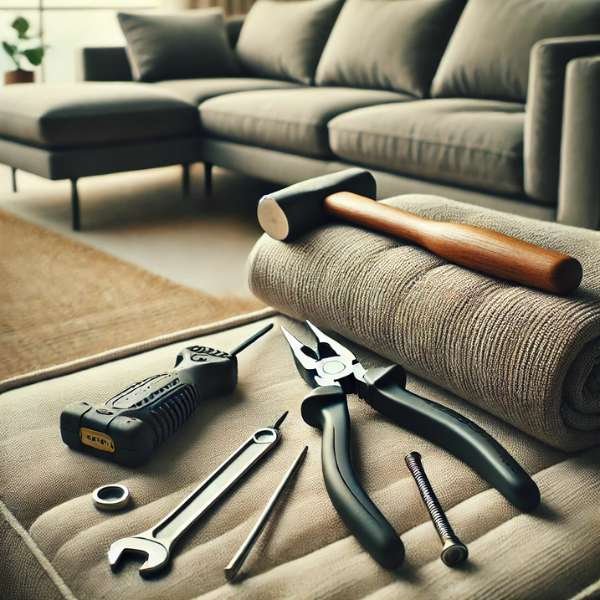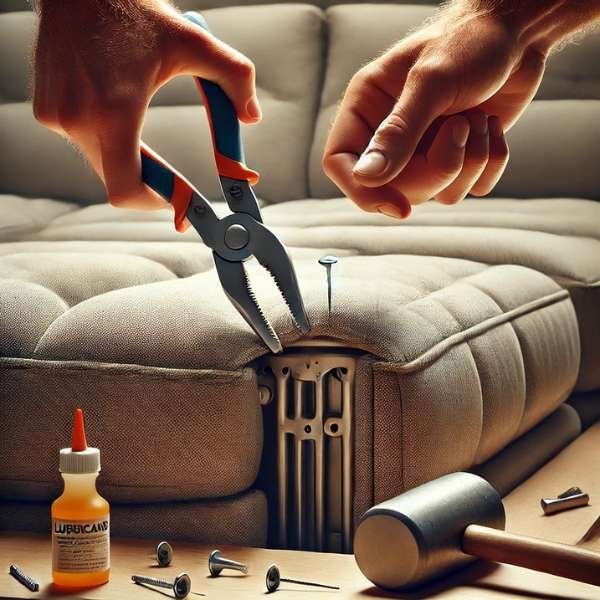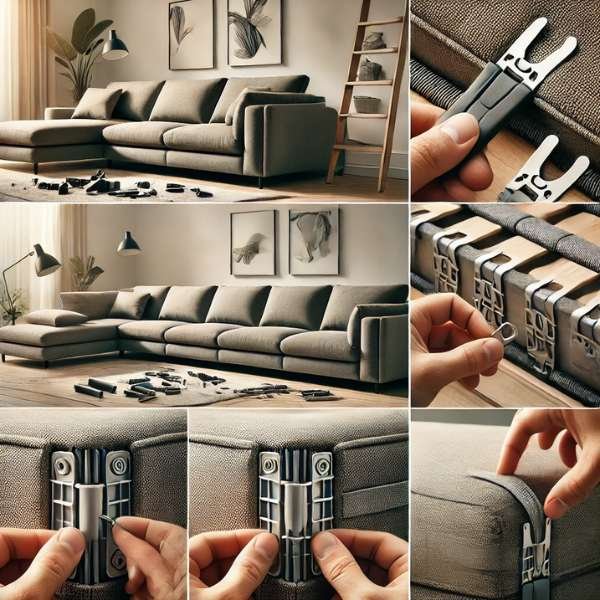Sectional sofas are a versatile centerpiece in many living rooms, providing a customizable approach to seating that accommodates various room layouts and preferences. Whether you need to rearrange, relocate, or simply clean around your sofa, disassembling it may seem like a daunting task at first. Fortunately, it’s not as difficult as it appears, especially once you understand how the pieces are connected. Many sectionals are held together by simple sofa pins—small but effective mechanisms that keep the individual sections securely locked in place. Knowing how to disconnect a sectional sofa with pins can save you time, and effort, and prevent unnecessary frustration.
Understanding Your Sectional Sofa Structure

Sectional sofas come in a variety of designs, each serving different purposes in a living space. Some are straight-lined, made up of just a few large pieces, while others include chaise sections, rounded corners, or even modular configurations that allow for ultimate flexibility. The key to safely disconnecting your sectional lies in understanding the sofa pins that hold everything together. These pins, typically hidden from view, serve to anchor one piece of the sectional to another, ensuring stability. The placement of these pins varies depending on the type of sectional, but they are usually located at the junctions where two pieces meet, often at the base or underneath the sofa.
Tools You’ll Need for the Job

Disassembling a divisional sofa doesn’t require an arsenal of tools, but having the right items on hand can make the process significantly smoother. Basic tools include a pair of pliers, a flathead screwdriver, and possibly a mallet to help loosen stubborn pins. It’s also a good idea to have a soft cloth or towel to protect the sofa’s upholstery from scratches during the disconnection process. Before starting, clear the surrounding area to give yourself ample room for movement, and consider laying down a sheet or tarp to protect your floors from any accidental damage.
Step-by-Step Guide to Disconnecting a Sectional Sofa with Pins

The first step in disconnecting a divisional sofa is to locate the hidden pins that are holding the pieces together. Depending on your sectional’s design, you may need to lift or tilt the divan sections to access the pins. Once found, gently but firmly pull out the pins. If they are difficult to remove, use pliers to grip the pin firmly and wiggle it free. Be cautious during this step—applying too much force could damage the pins or the sofa itself. To avoid accidents, ensure your sectional is on a stable surface before beginning the disassembly process.
Loosening Tight Pins: What To Do If the Pins Won’t Budge

In some cases, the pins may be tightly wedged, making them hard to remove. If you encounter this, don’t panic. Start by using pliers to get a better grip on the pin, and gently twist and pull until it loosens. For particularly stubborn pins, applying a bit of lubricant to the base of the pin can help ease it out. If all else fails, tapping the base of the pin with a mallet can sometimes break the grip without damaging the surrounding material.
Taking Apart Different Sections: Where to Start

Disassembling a divisional sofa calls for understanding an appropriate place to begin. Begin at the corner, middle, or a particular phase primarily based on the layout of your sectional. For a divan with a chaise front room, the satisfactory method is to begin there, as those portions are normally the perfect to split. In the case of L-formed or U-shaped sectionals, beginning with a nook segment makes the disconnection procedure extra manageable. Handle every piece cautiously, assisting its weight to avoid accidental drops or mishaps. Proper attention ensures an easy and harm-loose disassembly.
Taking apart a sectional sofa can seem daunting, but starting with the right approach makes it manageable. Begin by identifying the connection points, typically hidden beneath the cushions. Carefully remove any attached hardware, then gently pull apart the sections. Use a friend for assistance to avoid damage and ensure safety during the process.
Handling Large Sectional Pieces Once Disconnected

Disconnecting the individual sections makes moving them necessary. Large and unwieldy pieces require proper lifting techniques to avoid injury. Heavy sections benefit from an extra set of hands from a friend or family member. Dragging sections should be avoided, as it may cause damage to both the sofa and the floors. For temporary storage, sections should remain upright on a protective covering to prevent dirt or wear.
Keeping the Pins for Reassembly: Organization Tips

Once the sectional is fully disassembled, it’s crucial to keep track of the pins for reassembly. Misplacing these small but vital components can lead to frustration when it’s time to reconnect the divan. The easiest way to stay organized is to place the pins in a small container or plastic bag. Label the bag with the sofa’s section names so you know exactly where each pin goes when reattaching the divan.
Reversing the Process: How to Reconnect Your Sectional Sofa

Reconnecting the sectional is essentially the reverse of disassembly. Start by aligning the pieces in the correct configuration, making sure the connecting points are properly lined up. Insert the pins back into their respective slots, gently pushing them until securely fastened. Ensure each section is firmly connected before using the sofa again.
Caring for Your Sectional During and After Disconnection

Keeping your sectional in top shape requires cleaning both before and after disconnection. Dust and dirt often accumulate in the crevices between sections, making it a good time to vacuum these areas during disassembly. For leather-based sectionals, making use of a leather-based conditioner will help hold the material’s suppleness and protection. For fabric sofas, using a gentle upholstery cleaner can freshen up the material and restore its look. Proper care ensures your sectional stays in excellent condition through the disassembly process.
When to Call in Professional Help

While disassembling a divisional sofa is typically a straightforward task, there are certain situations where it might be better to call in professional help. If the sofa is especially large, or if the pins are damaged and require special tools to remove, a furniture technician can save you time and effort. Additionally, if you’re unsure about how to reassemble the divan, hiring a professional ensures the job gets done correctly.
Common Mistakes to Avoid When Disconnecting a Sectional Sofa

One common mistake people make when disconnecting a divisional divan is applying too much force when removing the pins. This can damage both the pins and the sofa’s upholstery. Another frequent error is neglecting to label the pins or the divan sections, which can make reassembly a frustrating and time-consuming process. Always take your time and approach each step carefully.
How to Deal with Broken or Bent Sofa Pins

A bent or broken pin during the disconnection process isn’t cause for concern—replacements are readily available. Many hardware stores stock universal sofa pins that can easily substitute for damaged ones. For minor bends, using pliers to gently straighten the pin is usually enough to restore its functionality.
Storing Your Sectional Safely After Disconnection

Planning to store your sofa for an extended period? Wrapping each section in protective furniture covers prevents dirt buildup and reduces the risk of fabric fading. Storing the sections upright helps preserve their shape and prevents sagging over time.
Moving Your Sectional to a New Location

Relocating your divisional sofa to another room or home requires proper preparation. Wrap each section in moving blankets to prevent scuffs or tears during transport. Secure the pieces in the moving vehicle to keep them from shifting and avoid damage during transit.
Reassembling a Sectional in a New Room

Once you’ve moved the sectional to its new location, take the time to consider how the layout of the room affects the sofa’s placement. Ensure that the divan fits the new space both in terms of size and aesthetic. If needed, experiment with different configurations to find the one that best suits your room’s layout.
Can All Sectional Sofas Be Disconnected?

Not all divisional sofas are designed to be taken apart. Some are made as one continuous piece, while others use clips or brackets instead of pins. If your divan doesn’t have removable pins, consult the manufacturer’s instructions to determine whether it can be disassembled in another way.
Alternative Ways to Disassemble a Sectional Sofa

Aside from pins, some sectionals are held together by clips, brackets, or even velcro. Each mechanism requires a different approach to disconnection. Clips can usually be unhooked by hand, while brackets may need to be unscrewed. Understanding the type of connectors your sofa uses is key to successful disassembly.
How Long Does It Take to Disconnect a Sectional Sofa?

The time it takes to disconnect a divisional sofa depends on several factors, including the size of the divan and the type of connection used. For beginners, the process can take anywhere from 30 minutes to an hour, while those experienced in disassembly may complete the task in less time. Rushing the process can lead to mistakes, so it’s best to work carefully and methodically.
Maintaining Your Sectional Sofa for Long-Term Use

Regular maintenance of your divisional sofa can extend its lifespan and keep it looking new. Check the divan pins and joints periodically to ensure they remain secure. Tighten any loose pins, and address any signs of wear before they become more significant issues.
Conclusion:
Learning how to disconnect a sectional couch with pins gives flexibility and ease in terms of rearranging or moving furnishings. By mastering this simple talent, you may make the maximum of your sectional’s adaptability, ensuring it stays a practical and fashionable part of your private home for years yet to come. Take delight in your capacity to address this task with self-belief and experience the liberty it gives.

